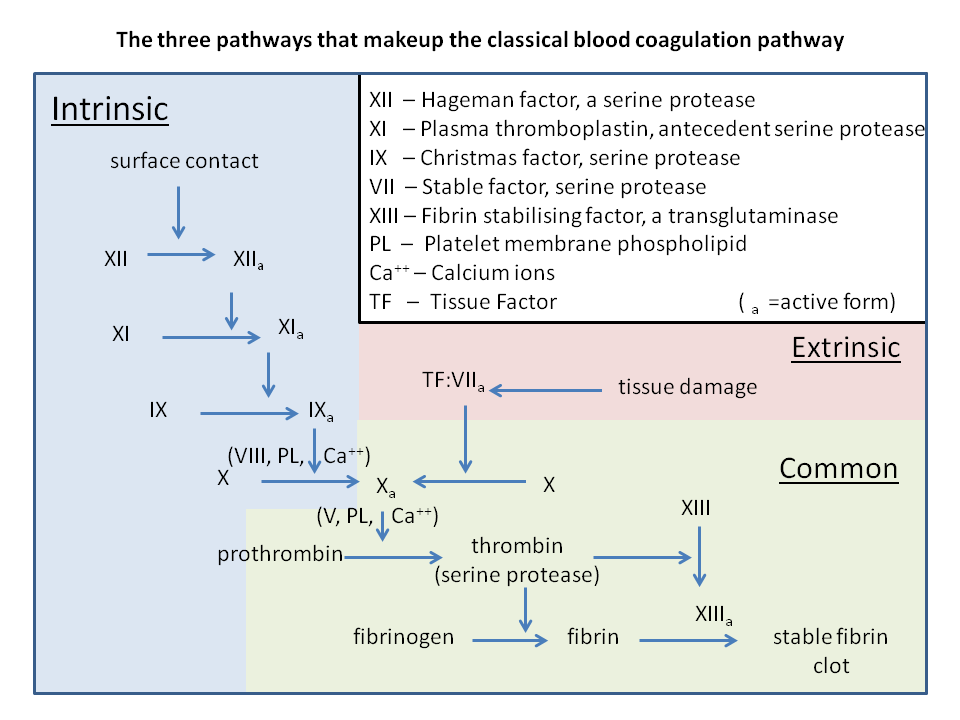Coagulation of Blood
Short Note by
Dr.A.P.Ganesan
Komarapalayam
Describe the extrinsic & intrinsic pathyways for coagulation of blood.
Definition
Solidification of blood to form a clot
Stages of Blood Coagulation
Three stages
1. Formation of prothrombin activator
2. Conversion of prothrombin into thrombin
3. Conversion of fibrinogen into fibrin
Formation of Prothrombin Activator
Two ways : -
a) Extrinsic pathway
b) Intrinsic pathway
Extrinsic Pathway
In this way coagulation occurs in the following stages : -
i) After injury the damaged tissues release tissue thromboplastin (Factor III) - The tissue thromboplastin initiates the intrinsic pathway. Thromboplastin contains proproteolytic enzymes
ii) The glycoprotein and phospholipid components of thromboplastin activate factor X, in the presence of factor VII.
iii) Activated factor X reacts with factor V and phospholipid component of tissue thromboplastin to form prothrombin activator. (This process requires the presence of Calcium ions).
Prothrombin activator converts prothrombin into Thrombin
iv) Thrombin in turn converts Fibrinogen into fibrin. This process involves Factors V, VIII and IX
Fibrin entangles the platelets and other cells of the blood and forms a clot
Intrinsic Pathway
Contact activation
When the endothelium is damaged, underlying collagen is exposed to circulating platelets.
Platelets bind directly to collagen with collagen-specific glycoprotein Ia/IIa surface receptors.
This adhesion is strengthened further by von Willebrand factor (vWF), which is released from the endothelium and from platelets.
vWF forms additional links between the platelets' glycoprotein and the collagen fibrils.
This localization of platelets to the extracellular matrix promotes collagen interaction with platelet glycoprotein VI.
Binding of collagen to glycoprotein VI triggers a signaling cascade that results in activation of platelet integrins.
Activated integrins mediate tight binding of platelets to the extracellular matrix.
This process adheres platelets to the site of injury.
Activated platelets will release the contents of stored granules into the blood plasma.
The granules include ADP, serotonin, platelet-activating factor (PAF), vWF, platelet factor 4, and thromboxane A2 (TXA2), which, in turn, activate additional platelets. T
Calcium concentration increased.
The calcium activates protein kinase C.
Protein kinase C activates phospholipase A2 (PLA2).
PLA2 increases the integrin membrane glycoprotein's affinity to fibrinogen.
The activated platelets change shape from spherical to stellate, and the fibrinogen cross-links with glycoprotein & aids in aggregation of adjacent platelets
The activated platelets form the primary complex on collagen by high-molecular-weight kininogen (HMWK), prekallikrein, and FXII (Hageman factor).
Prekallikrein is converted to kallikrein
And FXII becomes FXIIa.
FXIIa converts FXI into FXIa.
Factor XIa activates FIX
Activated FIX with its co-factor FVIIIa forms the tenase complex
Tenase complex activates FX to FXa.
Activated factor X reacts with factor V and phospholipid component of tissue thromboplastin to form prothrombin activator. (This process requires the presence of Calcium ions). Prothrombin activator converts prothrombin into Thrombin
Thrombin in turn converts Fibrinogen into fibrin. This process involves Factors V, VIII and IX
Fibrin entangles the platelets and other cells of the blood and forms a clot.
* * * * * * * * * * *
Which organs produce clotting factors?
The liver produces a cascade of clotting factors which contributes to the process of coagulation by breaking down fibrinogen into insoluble fibrin threads
What is the first reaction to a blood vessel injury?
Vasoconstriction
Which substances will alert the nurse for an increased risk of bleeding in a patient taking clopidogrel?
An increased bleeding with no other cause or link found should lead to possibility of herbal interactions with drugs. Other herbal sources that can increase risk of bleeding in patients taking anticoagulant include psyllium, turmeric, garlic, ginkgo, chestnut seed, Chamomile tea and goldenseal





